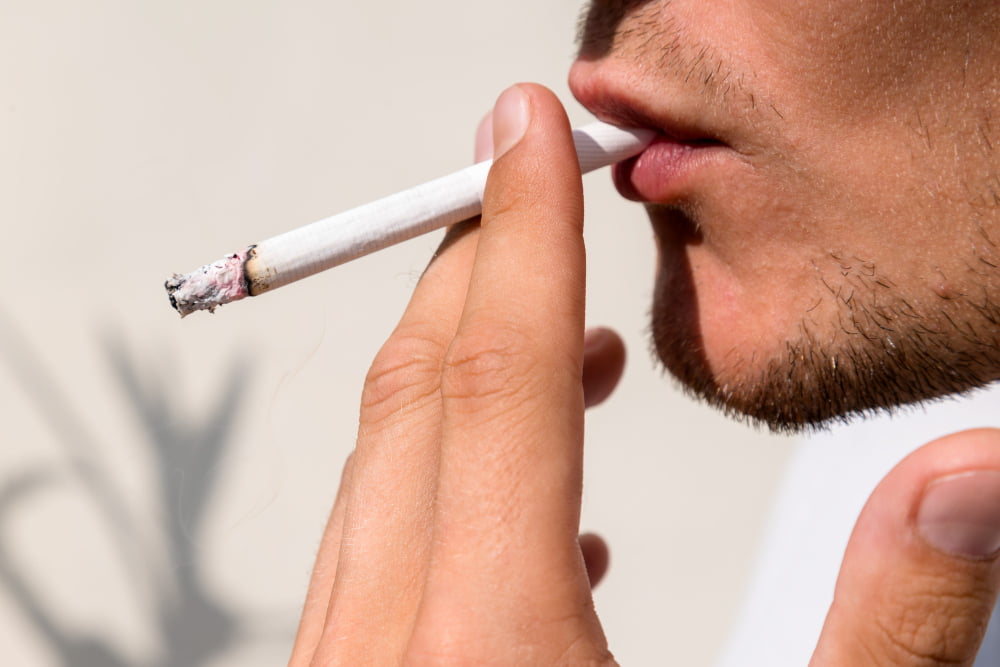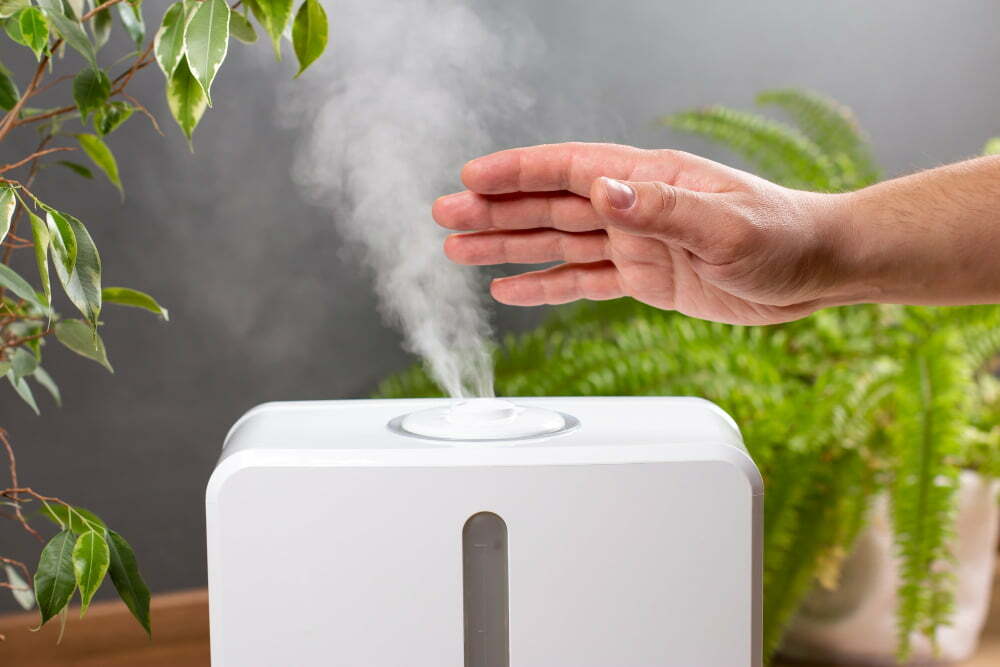Tobacco smoke and vaping can significantly degrade the indoor air quality, causing health concerns and unpleasant odors in your home.
As a child, I remember visiting my grandparents’ house and being greeted by the familiar scent of tobacco smoke. My grandfather was a heavy smoker, and his habit had permeated every corner of their home.
As I grew older and learned about the dangers of secondhand smoke, I became increasingly concerned about how it was affecting my health.
Fast forward to today, where we are faced with a new challenge in the form of vaping. While some argue that it is a safer alternative to smoking traditional cigarettes, there is still much debate over its impact on indoor air quality.
As someone who writes about home air quality, I feel compelled to delve deeper into this topic and help others understand the potential risks associated with tobacco smoke and vaping in our homes. So sit back, grab your favorite beverage (mine’s coffee), and let’s explore this issue together!
The Tale of Tobacco Smoke

The tale of tobacco smoke is a long and complicated one. For decades, smoking was considered a socially acceptable habit, with little thought given to its impact on indoor air quality.
It wasn’t until the 1960s that researchers began to uncover the dangers of secondhand smoke and its link to lung cancer. As awareness grew, so did efforts to regulate smoking in public spaces like restaurants and bars.
But what about our homes? Many people still smoked indoors, unaware of how it was affecting their loved ones’ health. Today we know that tobacco smoke contains over 7,000 chemicals – many of which are toxic or carcinogenic.
When someone smokes indoors, these chemicals can linger in the air for hours or even days after they’ve finished their cigarette. This means that non-smokers who share space with smokers are at risk for respiratory problems like asthma attacks and bronchitis as well as more serious conditions such as heart disease and lung cancer.
So if you’re still smoking inside your home (or allowing others to do so), it’s time to reconsider your habits for both your own health and those around you!
Vaping: A Modern Menace

While tobacco smoke has been a long-standing concern for indoor air quality, vaping is a relatively new phenomenon that has gained popularity in recent years. As someone who grew up with the smell of cigarette smoke lingering in my grandparents’ home, I was initially relieved to hear that vaping was being touted as a safer alternative.
However, as more research emerges on the potential health risks associated with e-cigarettes and vaporizers, it’s becoming clear that they may not be as harmless as we once thought.
One of the main concerns surrounding vaping is its impact on indoor air quality. While e-cigarettes don’t produce traditional cigarette smoke (which contains harmful chemicals like carbon monoxide and tar), they do emit aerosols or “vapor” which can contain potentially harmful substances such as nicotine and heavy metals like lead.
In fact, studies have shown that these aerosols can linger in the air for hours after use and settle onto surfaces throughout your home – including carpets, furniture upholstery and even walls! This means that anyone living or spending time in an environment where people are regularly using e-cigarettes could be exposed to these particles over an extended period of time.
So while vaping may seem like a modern solution to smoking-related health problems at first glance – it’s important to remember there are still many unknowns when it comes to their impact on our indoor environments.
Secondhand Smoke’s Silent Threat

As I mentioned in the intro, secondhand smoke was a familiar presence in my grandparents’ home. What I didn’t realize at the time was just how dangerous it could be.
Secondhand smoke contains over 7,000 chemicals, many of which are known to cause cancer and other health problems. Even if you don’t smoke yourself, being exposed to secondhand smoke can have serious consequences for your health.
It’s been linked to an increased risk of lung cancer, heart disease, stroke and respiratory infections like pneumonia. But what about indoor air quality? Well unfortunately for non-smokers living with smokers or even those who live near smokers may experience poor indoor air quality due to tobacco smoking as well as vaping indoors.
The particles from cigarette or vape emissions can linger in the air long after they’ve been exhaled and settle on surfaces throughout your home – including carpets and furniture – where they continue releasing toxins into the environment. So while we may not always see or smell it right away (like my childhood memories), secondhand smoke is a silent threat that should not be ignored when considering our overall indoor air quality levels at home.
E-Cigarettes Vs Traditional Cigarettes

When it comes to indoor air quality, both traditional cigarettes and e-cigarettes can have a significant impact. While traditional cigarettes release smoke into the air, e-cigarettes emit aerosols that contain harmful chemicals such as nicotine and formaldehyde.
As I continued my research on this topic, I couldn’t help but think about my grandfather’s smoking habit and how it affected not only his health but also the health of those around him. Now with vaping becoming more popular among younger generations, it’s important to consider its potential impact on indoor air quality as well.
While some argue that e-cigarettes are a safer alternative to traditional cigarettes because they don’t produce smoke or tar, studies have shown that their emissions still pose risks for respiratory problems and other health issues. In fact, according to the American Lung Association (ALA), “e-cigarette aerosol is not harmless ‘water vapor,’ but actually contains potentially harmful chemicals.”
So whether you’re dealing with tobacco smoke or vaping in your home or workplace environment – understanding their effects on indoor air quality is crucial for maintaining good respiratory health.
Ventilation: A Breath of Fresh Air

As I mentioned earlier, my grandfather’s smoking habit had a significant impact on the air quality in his home. The smell of smoke was everywhere, and it made me feel uncomfortable and uneasy.
It wasn’t until years later that I learned about the dangers of secondhand smoke and how it can lead to respiratory problems like asthma or even lung cancer.
One way to combat this issue is through proper ventilation. Ventilation systems help circulate fresh air throughout your home while removing stale or polluted air.
This can be achieved through natural ventilation (opening windows) or mechanical ventilation (using fans or HVAC systems).
When it comes to vaping, there is still much we don’t know about its long-term effects on indoor air quality. However, studies have shown that e-cigarettes release harmful chemicals into the environment such as formaldehyde and acetaldehyde.
Regardless of whether you’re dealing with tobacco smoke or vaping fumes, proper ventilation is crucial for maintaining good indoor air quality in your home. So next time you light up a cigarette indoors or take a puff from your vape pen, remember that opening a window could make all the difference for both yourself and those around you!
Health Hazards Lurking Indoors

As I mentioned earlier, my grandfather’s smoking habit had a profound impact on the air quality in his home. But what exactly are the health hazards associated with tobacco smoke and vaping indoors?
Firstly, let’s talk about tobacco smoke. According to the American Lung Association, secondhand smoke contains over 7,000 chemicals – many of which are toxic and can cause cancer.
Exposure to secondhand smoke has been linked to respiratory infections, asthma attacks, heart disease and stroke.
Now onto vaping – while it is often marketed as a safer alternative to smoking traditional cigarettes due to its lack of tar and carbon monoxide emissions; there is still much we don’t know about its long-term effects on our health. Vaping devices emit aerosols that contain harmful chemicals such as formaldehyde and acrolein which can irritate our eyes, nose or throat.
It’s clear that both tobacco smoke and vaping have serious implications for indoor air quality – but what steps can we take towards improving it? Let’s explore some solutions in the next section!
Protecting Your Home Sanctuary

As I mentioned earlier, my childhood memories of visiting my grandparents’ home were tainted by the smell of tobacco smoke. It wasn’t until later in life that I realized just how harmful secondhand smoke can be to our health.
But now, with the rise of vaping and e-cigarettes, we are faced with a new challenge when it comes to protecting our indoor air quality.
Whether you or someone in your household smokes traditional cigarettes or uses an e-cigarette device for vaping, there are steps you can take to protect your home sanctuary from harmful pollutants. One simple solution is investing in an air purifier specifically designed for removing cigarette smoke and other airborne contaminants.
Another important step is ensuring proper ventilation throughout your home. This means opening windows regularly (weather permitting) and using exhaust fans when cooking or showering to help remove any lingering pollutants from the air.
If smoking indoors cannot be avoided altogether (such as during inclement weather), designate a specific area away from living spaces where smoking/vaping is allowed and ensure proper ventilation measures are taken within that space.
By taking these proactive steps towards protecting indoor air quality within our homes – whether it’s due to traditional cigarette use or vaping – we can create a healthier environment for ourselves and those around us who may be sensitive to these pollutants.